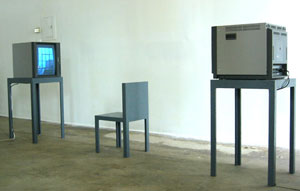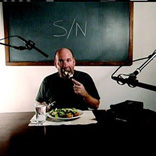The Further Back I Look the Further Forward I Can See, new work by New York artist Steve Hamilton currently showing at the Triangle Project Space, utilizes video and sound with such spare precision, it negates being ensconced by the cloud cover of popular entertainment, relying instead on the documentation of small mundane occurrences to illustrate large and universal questions.

Steve Hamilton, Middle East (The Further Back I look the Further Forward I can See), 2003... Total running time 35 mins
The show consists of three separate video installations, each minimal in its aesthetic, but well considered in its placement. The first piece one encounters on entering the gallery space is Middle East (The Further Back I look the Further Forward I can See), 2003. Taking its title from a quote made by Winston Churchill leading up to England’s involvement in World War II, the piece consists of two monitors resting on identical gray tables with a chair spaced evenly between the two. Each screen records the pre-dawn morning, the setting moon and rising sun from two separate vantage points within the artist’s studio. In the first, steam and fog punctuated by small twinkling lights envelop the industrial landscape. The city, cast in the hues and romanticism of a whistler painting, is defined by the gridded glass window of the artists’ studio. The dominant presence of the grid imposes an analytical order onto the cityscape, referencing both classical western systems for describing space, and a formal reliance on the grid adopted by many artists in the second half of the 20th century.
From the second screen, which presumably faces the back of any viewer who chooses to sit down, an eastward view of the city slowly emerges with the rising sun. From virtual blackness comes an irregularly shaped view of distant buildings and sky, seen through the crumbling frame of a hole gouged into the wall. Less complete and thus more mysterious than the westward perspective, the gradual emergence of the city is so subtle, it’s like watching clouds move in and out of focus over the coarse of an afternoon.
In this piece the viewer is positioned between two parallel events, each defined in large part by the way in which they are framed. With the addition of the title, it is impossible not to draw conclusions based on the disharmony of recent world events resulting from incongruous systems of belief. Through a simple shift in perspective the artist is able to radically manipulate our understanding of the world, creating an experience that is both poignant and timeless.
The recording of time also becomes a major theme in another piece in the show, The History of Chance completed in 2002. Two video monitors, each set into the wall, vertically bookend a similarly sized glassed-in alcove. The upper video, almost abstract in its simplicity, records the sounds of wind moving through alleyways and the gentle brushing of a window blind chain against the wall. The lower video, also quite simple, records the never-ending drip…drip…drip… of water into an inky abyss. The alternating sounds and flickering images imply, like the act of breathing, a life sustaining rhythm: persistent, and yet at times invisible. The fluid nature of the two videos contrasts sharply with the small pile of finger and toenail clippings entombed within a teardrop-shaped glass bubble that rests in the center of the alcove. Static and a bit disgusting, the nail clippings (which represent ten years of the artist’s life) remind the viewer of our ultimate inconsequentiality against the vast continuum of time.
In the final video in the show, S/N (referencing the abbreviation for the ratio of a recorded sound to the background noise of an environment), Hamilton records himself sitting at a non-descript desk eating a very crunchy salad. Microphones are directed towards his mouth and away from his body. A black board hangs behind him with "S/N" scrawled in white chalk. The scene closely mimics the strangely creepy aesthetic of an institutional instructional video, bland and under control. The audio, on the other hand, which must be heard through one of three sets of headphones, is decidedly not under control. The sounds of breathing, chewing, grinding and crunching are so loud, it is hard to connect them with the corresponding image. Instead one imagines medieval horses sloshing through mud, wild ravenous mountain pigs rooting around for truffles, or giant chunks of iceberg crashing into the sea. In S/N it is the ratio of presumption to sensory reception that transforms the hyper-real record into a surreal experience.
The Further Back I Look the Further Forward I Can See, curated by Jennifer Jankauskas, is the 2nd show for the newly conceived Triangle Project Space, an endeavor focused on bringing experimental and new media art to San Antonio, and founded by Luz Maria Sanchez and Peter Glassford.
Images courtesy the artist and Triangle Project Space.
Joey Fauerso is an artist and co-director of the Bower gallery. She lives in San Antonio, TX.




